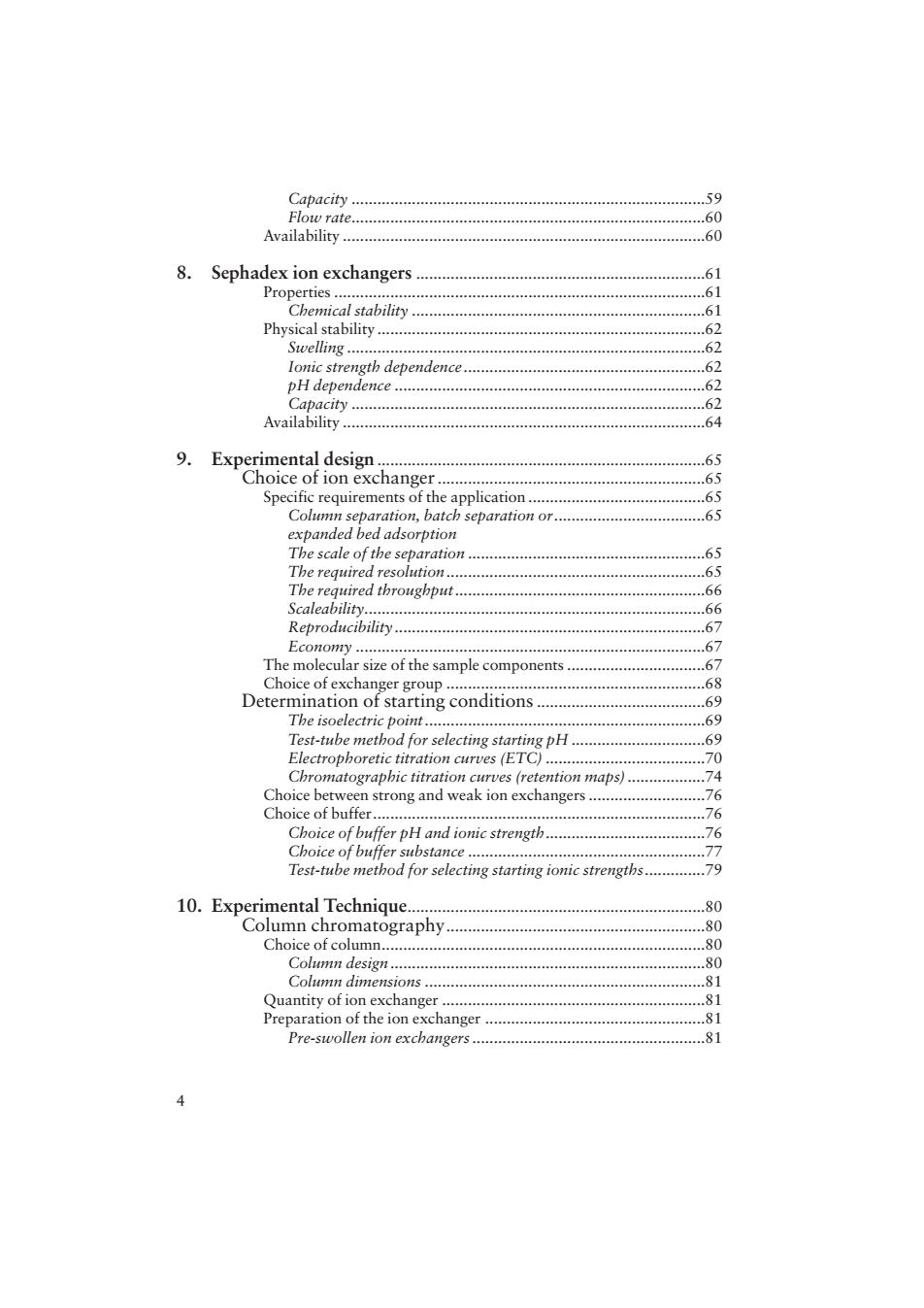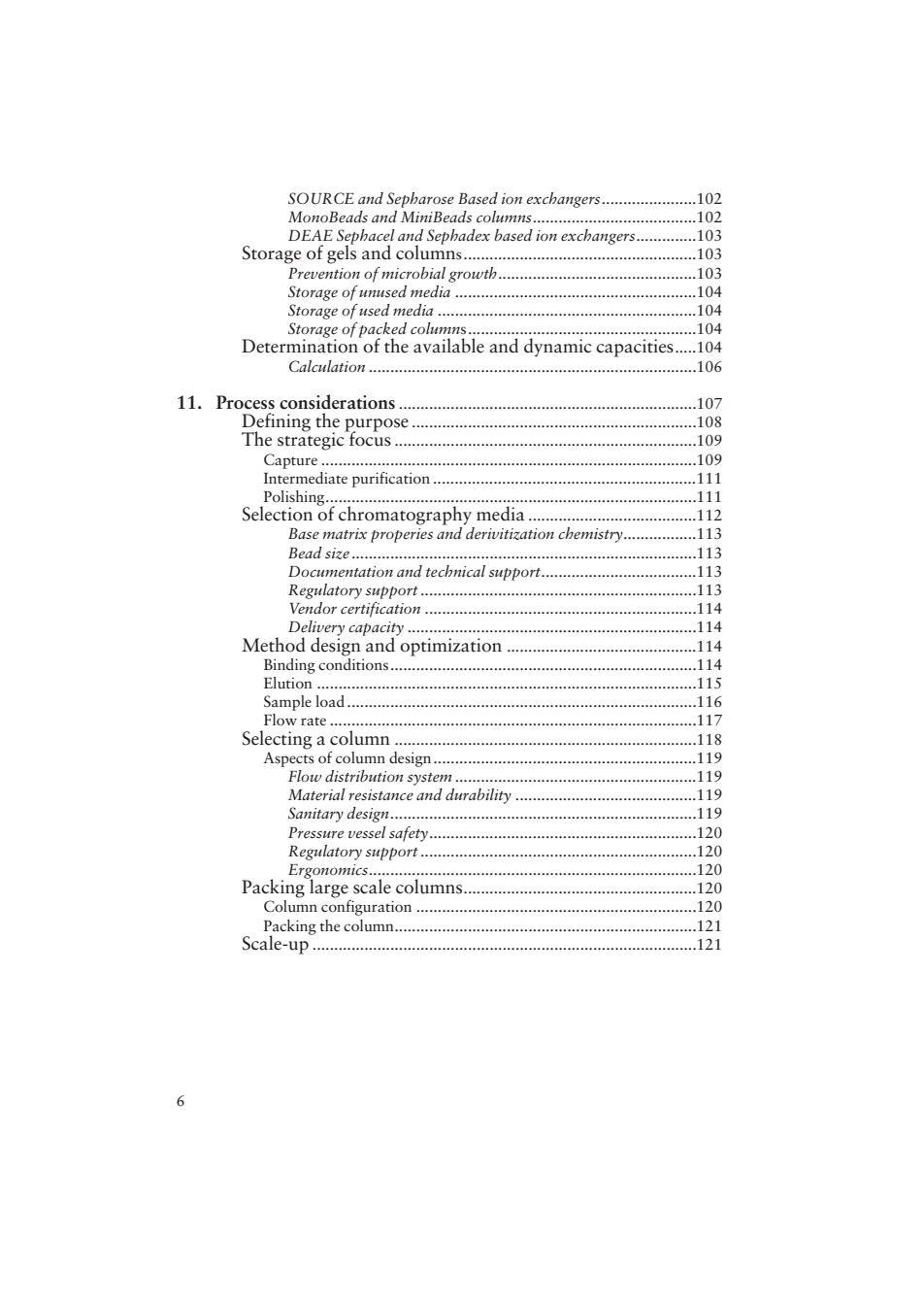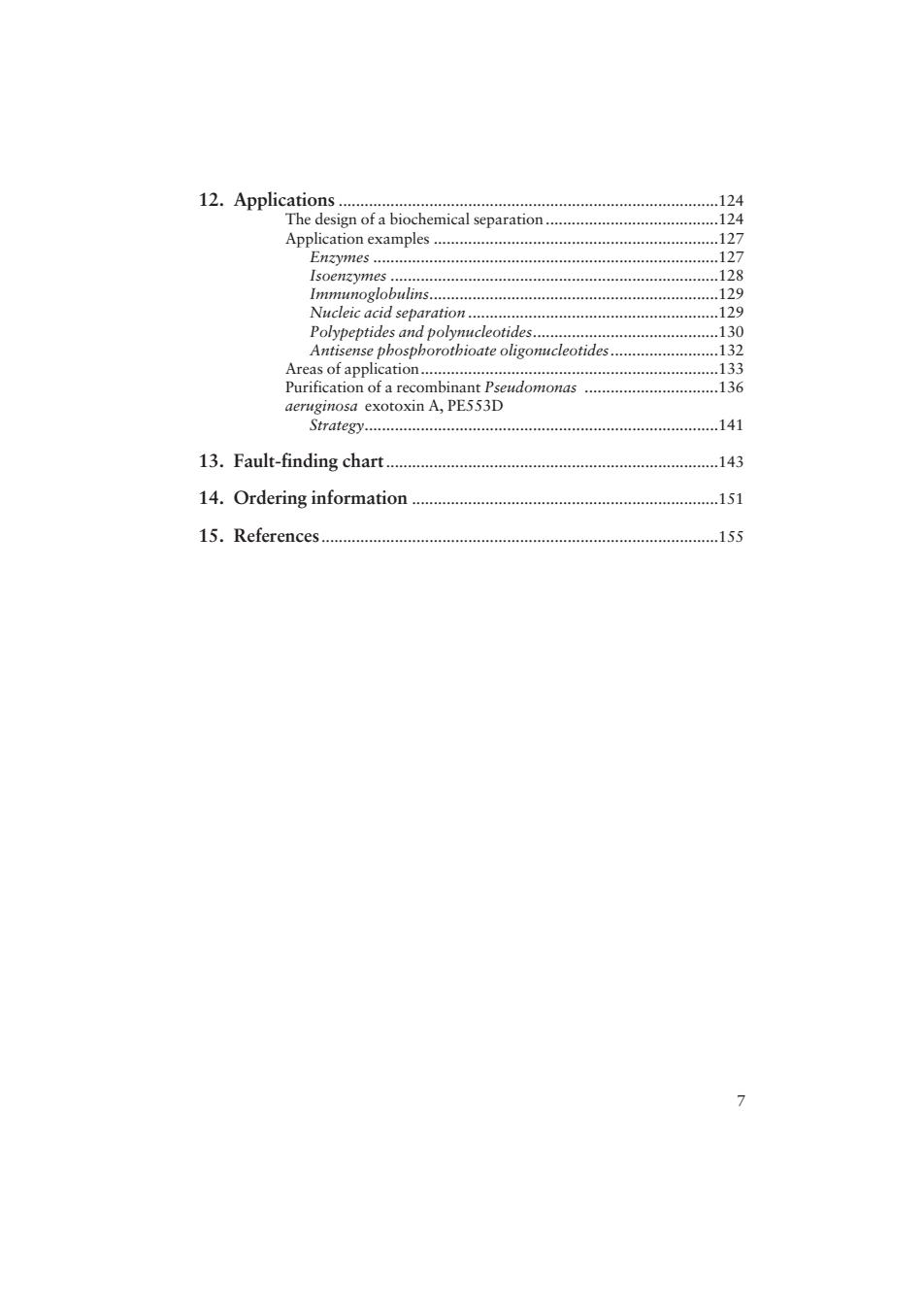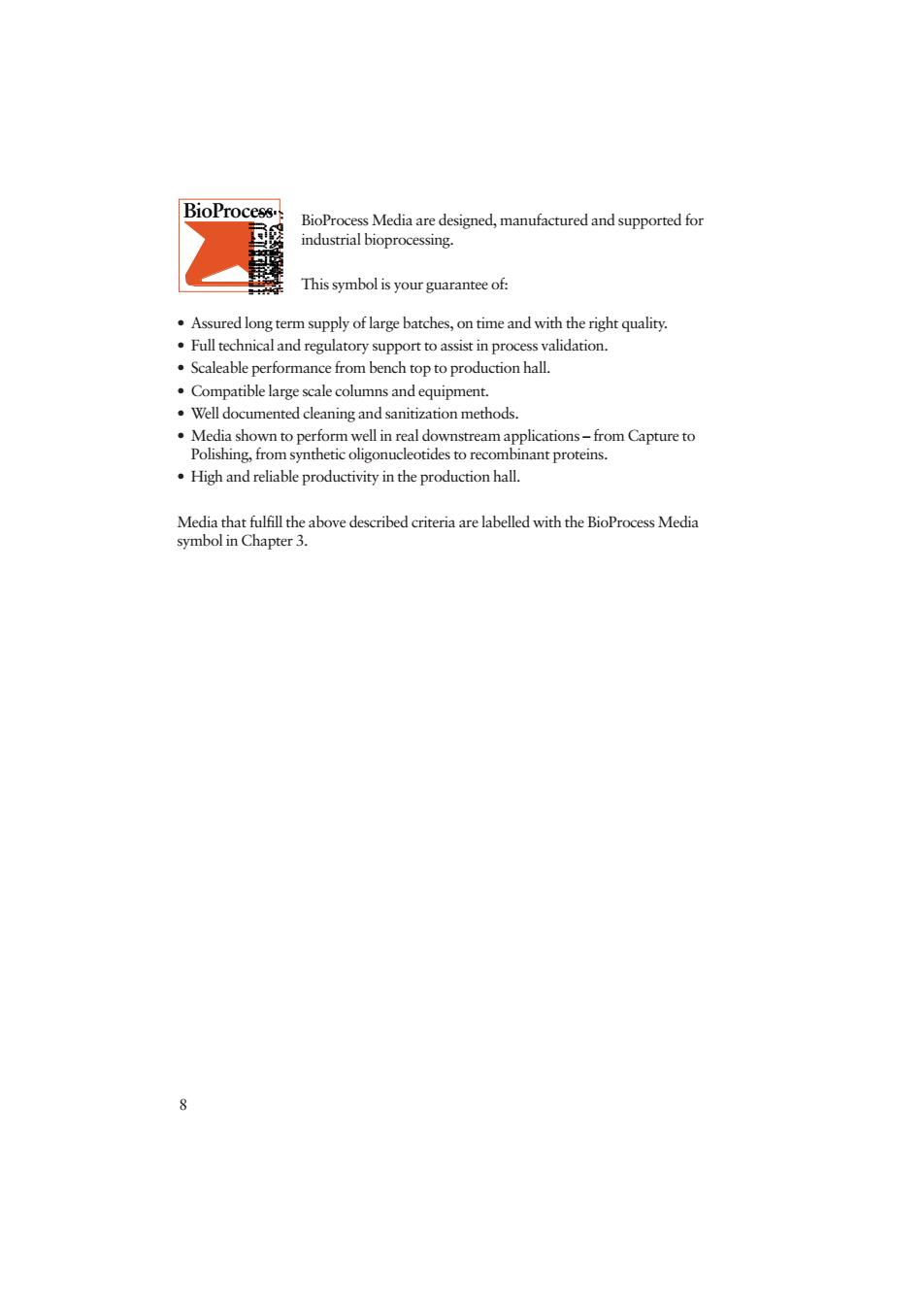
Capacity 59 8. Sephadex ion exchangers 6 .61 astability lonic strength dependence. nce 64 9. .65 requirements of the application 65 6 66 6> . Determination of starting conditions .69 mg pH ention maps). 10. que Choice of column ography 80 Quantity of ion exchanger 81 . re-st exc
Capacity .59 Flow rate.60 Availability .60 8. Sephadex ion exchangers .61 Properties .61 Chemical stability .61 Physical stability .62 Swelling .62 Ionic strength dependence.62 pH dependence .62 Capacity .62 Availability .64 9. Experimental design .65 Choice of ion exchanger.65 Specific requirements of the application .65 Column separation, batch separation or.65 expanded bed adsorption The scale of the separation .65 The required resolution.65 The required throughput.66 Scaleability.66 Reproducibility .67 Economy .67 The molecular size of the sample components.67 Choice of exchanger group .68 Determination of starting conditions.69 The isoelectric point.69 Test-tube method for selecting starting pH .69 Electrophoretic titration curves (ETC) .70 Chromatographic titration curves (retention maps).74 Choice between strong and weak ion exchangers.76 Choice of buffer.76 Choice of buffer pH and ionic strength.76 Choice of buffer substance .77 Test-tube method for selecting starting ionic strengths.79 10. Experimental Technique.80 Column chromatography.80 Choice of column.80 Column design.80 Column dimensions .81 Quantity of ion exchanger .81 Preparation of the ion exchanger .81 Pre-swollen ion exchangers.81 4

Pre-packed ion excbange media Pac 82 Sample pr centration. 85 Ot 89 Change of pH Change o ionic strenoth 97 of gradient typ Resolution using a ntinuous gradient. .9 9 Gradient generation Gradient mps or a single pump Gradient Mixer. 96 Batch separation 9 operation 10 10 equipment. .10 10 Cleaning .10 0 i-lace (CIP) .10 5
Pre-packed ion exchange media .81 Sephadex ion exchangers .82 Alternative counter-ions.82 Decantation of fines.82 Packing the column.82 Column Packing Video Film.82 Checking the packing.83 Equilibrating the bed .84 Sample preparation.85 Sample concentration.85 Sample composition.85 Sample volume.85 Sample viscosity.85 Sample preparation.86 Sample application .87 Sample application with an adaptor.87 Other methods of sample application.89 Sample application onto a drained bed.89 Sample application under the eluent.89 Elution .90 Change of pH .90 Change of ionic strength .91 Gradient direction.91 Choice of gradient type .91 Resolution using a continuous gradient.93 Choice of gradient shape .94 Sample displacement.95 Gradient generation.96 Gradient formation with two pumps or a single pump .96 in combination with a switch valve Gradient Mixer.96 Batch separation.97 Expanded bed adsorption .98 Expanded bed technology .99 Basic principle of operation.99 STREAMLINE adsorbents .100 STREAMLINE columns .100 Auxiliary equipment.100 Regeneration .101 Cleaning, sanitization and sterilization procedures.101 Cleaning .101 Sanitization .101 Sterilization .101 Protocols for cleaning-in-place (CIP),.102 sanitization and sterilization 5

10 Storage of gels and col nns. ntion of mic 03 04 Storage of used media Calculation. 106 11.Pro nsideration .10 Defin g the purpose. 08 he strategic mediate purification 111 Base matrix prope 113 nd technical s 113 Vendor certifica Method des n and optimization 114 Binding conditions. oad 16 e Flow rate .11 ting a 9 Pressure vessel safety Packing large scale columns. Scale-up 121 6
SOURCE and Sepharose Based ion exchangers.102 MonoBeads and MiniBeads columns.102 DEAE Sephacel and Sephadex based ion exchangers.103 Storage of gels and columns.103 Prevention of microbial growth.103 Storage of unused media .104 Storage of used media .104 Storage of packed columns.104 Determination of the available and dynamic capacities.104 Calculation .106 11. Process considerations.107 Defining the purpose .108 The strategic focus.109 Capture .109 Intermediate purification .111 Polishing.111 Selection of chromatography media .112 Base matrix properies and derivitization chemistry.113 Bead size .113 Documentation and technical support.113 Regulatory support .113 Vendor certification .114 Delivery capacity .114 Method design and optimization .114 Binding conditions.114 Elution .115 Sample load .116 Flow rate .117 Selecting a column .118 Aspects of column design.119 Flow distribution system .119 Material resistance and durability .119 Sanitary design.119 Pressure vessel safety.120 Regulatory support .120 Ergonomics.120 Packing large scale columns.120 Column configuration .120 Packing the column.121 Scale-up .121 6

12.Applications. PP 12 12g Areas of application. .13 Strategy. .141 13.Fault-finding chart. l43 14.Ordering information. .151 15.References. 155
12. Applications.124 The design of a biochemical separation .124 Application examples .127 Enzymes .127 Isoenzymes .128 Immunoglobulins.129 Nucleic acid separation .129 Polypeptides and polynucleotides.130 Antisense phosphorothioate oligonucleotides.132 Areas of application.133 Purification of a recombinant Pseudomonas .136 aeruginosa exotoxin A, PE553D Strategy.141 13. Fault-finding chart.143 14. Ordering information .151 15. References.155 7

BioProcess. aninareadamanuhdmradandspadhar toprocessing· This symbol is your guarantee of .Assured long term supply of large batches,on time and with the right quality. .Full technical and regulatory sup oport to assist in process validation. Scaleable performance from bench top to production hall Compatible large scale columns and equipment. .Well documented cleaning and sanitization methods. .High and reliable productivity in the production hall. Media that fulfill the above described criteria are labelled with the BioProcess Media symbol in Chapter 3. 8
8 BioProcess Media are designed, manufactured and supported for industrial bioprocessing. This symbol is your guarantee of: • Assured long term supply of large batches, on time and with the right quality. • Full technical and regulatory support to assist in process validation. • Scaleable performance from bench top to production hall. • Compatible large scale columns and equipment. • Well documented cleaning and sanitization methods. • Media shown to perform well in real downstream applications – from Capture to Polishing, from synthetic oligonucleotides to recombinant proteins. • High and reliable productivity in the production hall. Media that fulfill the above described criteria are labelled with the BioProcess Media symbol in Chapter 3. BioProcess ?@f?@?@?@?/K ?@e@@?@?@?@?V4 ? @ ? ? @@@@@@6XfO26 S,?W2@@Y@ @@@@@@@U?7UI'X@ I/?@)?V4@? ? ?)X?'@?@?@@?W.? ?@)?V'e?@@?.Y? ? ?@@?? ? ? O2@?? @@e@?@@@@@U@?? B@@?? @@e@?@?@??@@??? ? ?@?@e?@@ @Khf? @@@@@@@?e?@e@? ?@f?@?@?@?/K ?@e@@?@?@?@?V4 ? @ ? ? @@@@@@6XeW2@@@ S,?W&@@X@ @@@@@@@U?7>(R@@ I/?@0Y?@@ ? ? ?@@?W.?@?@@??@? ?@@?.Y?@?@@?e? ? ?@@??? ? O2@?? @@e@?@@@@@U@?? B@@?? @@e@?@?@??@@??? ? ?@?@e?@@ @Khf? @@@@@@@?e@?@?@? ?@f?@?@?@?/K ?@e@@?@?@?@?V4? @ ? ? @@@@@@6Xe@?@?W S,?J@@@?7 @@@@@@@U?7@??J@ I/?@@??@@? ? ?@@??@e?@@?@?? ?@@?e?@g?? ?@@??? ? O2@?? @@e@?@@@@@U@?? B@@?? @@e@?@?@??@@??? ? ?@?@e?@@ @Khf? @@@@@@@?e@@?@? ? ?@f?@?@?@?/K ?@e@@?@?@?@?V4? @ ? ? @@@@@@6Xe@6T26 S,?J@@@R4 @@@@@@@U?7@V'9? I/?@@?V4@? ? ?@@?@??@?@@?e?? ? ?@@??? ? O2@?? @@e@?@@@@@U@?? B@@?? @@e@?@?@??@@??? ? ?@?@e?@@ @Khf? @@@@@@@??@f@? ?@f?@?@?@?/K ?@e@@?@?@?@?V4? @ ? ? @@@@@@6Xe@@@6T S,?J@@@>@ @@@@@@@U?7@(R@> I/?@0Y?@0? ? ?@@?e?@g?? ? ?@@??? ? O2@?? @@e@?@@@@@U@?? B@@?? @@e@?@?@??@@??